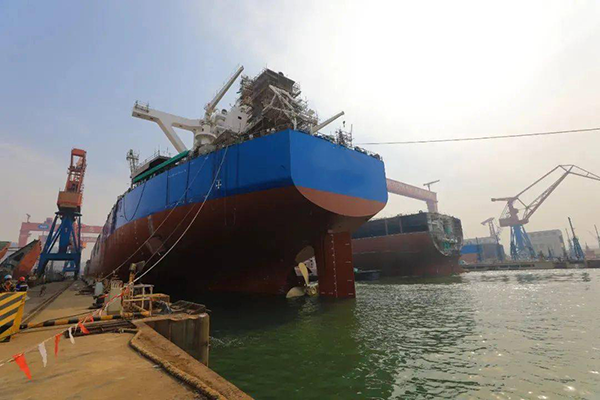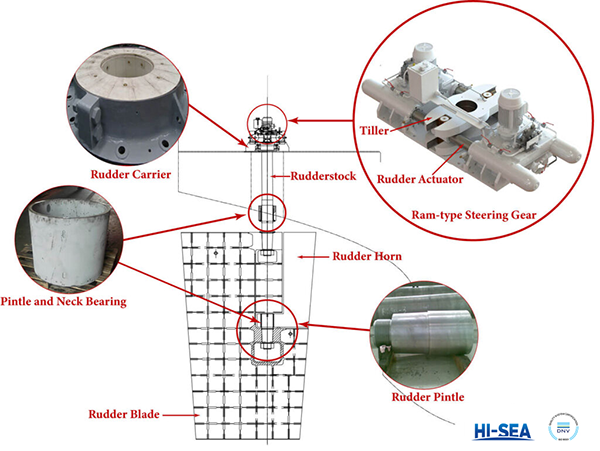Installation Precautions of Rudder System (Reference)
Installation Precautions of Rudder System (Reference)
Rudder installation (with hydraulic trolley)
Rudder blade and rudder stock parts are manufactured → Rudder blade and rudder stock are transported to the dock → The bushing at the upper and lower rudder buttons is installed by the freezing method → The upper rudder bearing is hoisted into the steering gear room in advance → The rudder stock is hoisted from the enclosure → Install the hydraulic trolley for the rudder blade in the dock → Put the rudder blade on the hydraulic trolley → Use the rail to move the hydraulic trolley to the desired position → Raise the hydraulic trolley so that the rudder blade and rudder pin are inserted into the rudder knob → Lower the rudder stock ,Using temporary fixing screws and positioning pins to align the screw holes on the rudder stock flange with the corresponding screw holes on the rudder blade → Install the connecting bolts between the rudder stock and the rudder blade by the freezing method → rudder stock, assemble with the upper rudder bearing Good → Install the detachable part of the rudder blade → Measure the gap between the rudder blade and the rudder button, and process the anti-jump block → Install the anti-jump block → Seal the connection between the rudder blade and the rudder stock with cement → Install the tiller → Submit the rudder system for inspection → Carry out the rudder blade efficiency test (the swing angle of the rudder blade should be greater than the mechanical limit of the steering gear) → mark the "0" position on the tiller handle → painting → inspection.

Common faults of the rudder system
The rudder system is rarely repaired except for the average accident, which has a long service life. The overhaul of the rudder system can be carried out along with the overhaul of the coaxial system. The rudder system generally produces the following faults in actual operation:
(1) The rudder is heavy and the steering is not sensitive, and it takes a long time to fully turn the rudder. When the steering gear functions normally, it may be that the rudder blade enters the water, which increases the load of the rudder; the rudder stock is bent or twisted, so that the load of each rudder is uneven, and the friction force increases; the rudder bearing is damaged; Caused by face jam, etc.
(2) The sound is abnormal when the rudder is turned, and there is a serious impact phenomenon. The main reasons are that the clearance between the rudder bearing and the rudder stock, rudder shaft, rudder pin, etc. is too large, the rudder blade collides from left to right when the rudder is turned, or the balls of the upper rudder bearing are broken, the retaining ring is loose, and the rudder is heavy and has a collision...
(3) The rudder turning is not accurate, the ostrich horn is not straight, and the rudder angle is not in the fog position when the rudder is straight. When the rudder angle indicator is normal, it is mainly caused by the following reasons: the rudder stock is twisted and deformed, and the direction of the rudder blade changes accordingly; when the rudder is installed, the rudder angle is not aligned with the fog level. When the rudder angle indicator has a fault indication error, the rudder turning is also inaccurate.
(4) Steering is easy, but the heading is out of control. It may be caused by the breakage of the rudder stock or the falling off of the flange bolts connecting the rudder stock and the rudder blade, causing the rudder blade to fall into the water and lose it.
(5) Vibration of the rudder system. Mainly due to the improper installation of the rudder system, excessive rudder bearing clearance, insufficient hull strength and rigidity at the rudder system installation position, and insufficient strength of the upper rudder bearing base.
(6) Leakage caused by damage to the sealing device of the rudder system.
Rudder system maintenance advice
1. Inspection before the dismantling of the rudder system
1) Visual inspection
(1) People stand at the stern and visually check whether the ostrich leaves are centred in the cloud position of the rudder angle;
(2) Visually inspect the rudder blade and rudder stock for deformation such as bending and twisting;
(3) The rudder flexibility of the boat can be checked by turning the rudder blade by hand;
(4) Check the sealing device for damage.
2) Measurement
Use a feeler gauge to measure and check the clearance of each fitting to determine the technical state of the rudder system and determine the repair plan.
( 1 ) Measure the fitting clearance between the rudder stock and the rudder bearing and the clearance between the rudder shaft and the iron pear rudder bearing. Measure and record the clearances in front, rear left, and right of the bearing when the rudder is at full left, full right, and centre. When the structural limit cannot be measured with a feeler gauge, the rudder blade can be moved by the kilogram item. The movement of the rudder blade can be measured with a dial indicator to obtain the matching clearance.
(2) Measure the clearance between the rudder pin and the rudder pin bearing, and the plane clearance between the rudder blade rudder button and the stern column rudder button. The rudder button on the rudder blade and the rudder button on the stern column are connected by a rudder pin (the rudder button on the stern column and the copper bushing constitute a rudder pin bearing). The lower part of the rudder blade is supported by a rudder bottom bracket. Measure the clearance between the rudder pin and the rudder pin bearing, the gap between the plane of the rudder blade rudder button and the stern column rudder button and compare with the standard.
2. Overhaul of the rudder stock
1) The rudder stock is an important part of the rudder system.
( 1 ) Wear detection of the working shaft diameter of the rudder stock: Measure the diameter of the working shaft diameter and calculate its roundness and cylindricity errors.
(2) Detection of corrosion and cracks on the surface of the rudder stock: Use penetrant inspection, magnetic particle inspection or ultrasonic inspection to detect the corrosion and cracks on the surface of the rudder stock.
(3) Detect the bending shape of the rudder stock on a lathe or a bracket.
2) Repair the rudder stock
(1) When the rusted area of the working shaft diameter of the rudder stock exceeds 25% of the total area, bare car, repair welding or surfacing stainless steel should be carried out. The depth does not exceed 0.5mm of Tsuji.
(2) When a protective sleeve is installed on the working shaft of the rudder stock, it should be repaired with a bare car after wear, and the wall thickness of the protective sleeve should meet the regulations.
(3) Repair of rudder stock cracks: When there are 2-3 small longitudinal cracks on the rudder stock, it can be repaired by hand; Depth not exceeding 5% of the nominal diameter can be repaired; transverse cracks on the rudder stock are not allowed.
3. Overhaul of rudder bearing
(1) Overhaul of the upper rudder bearing: Most of the upper rudder bearings are rolling bearings, when the bearing is rusted, or eroded, the retainer is broken, the ball (roller) is severely worn or broken, and the rotation is inflexible, it should be replaced.
(2) Overhaul of other sliding bearings: White alloy or iron pear sliding bearings are seriously worn, and when they are repaired, re-cast white alloy or replace iron pear respectively.
4. Overhaul of rudder blades
(1) Rudder blade replacement plate
(2) Repair of rudder blade cracks
(3) Local corrosion repair of rudder blades
(4) Repair of rudder blade with side deflection
(5) Rudder blade painting
(6) Repair of the deflector and rudder


 Tel:+86-23-67956606
Tel:+86-23-67956606 Email:
Email:
